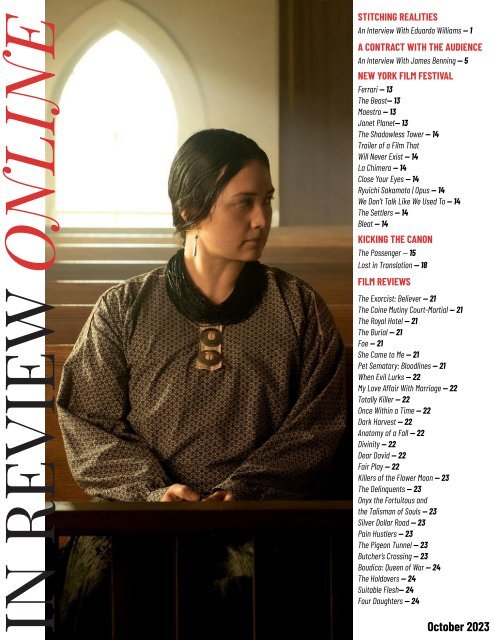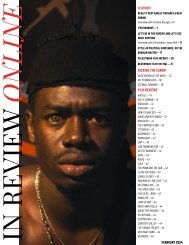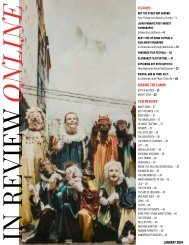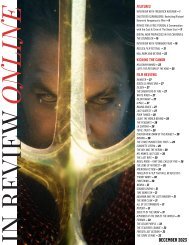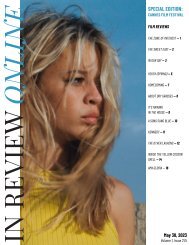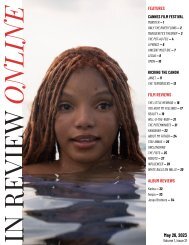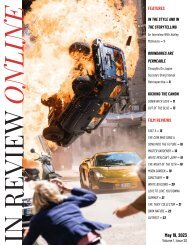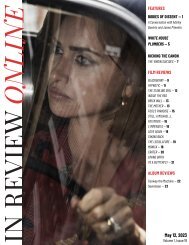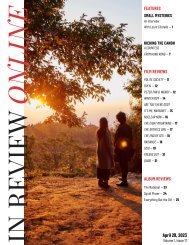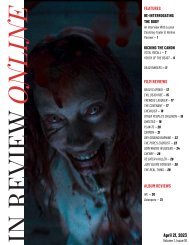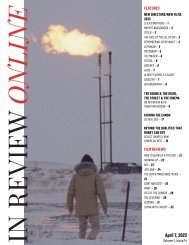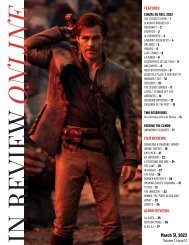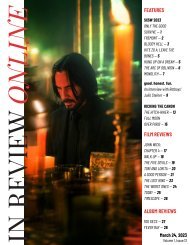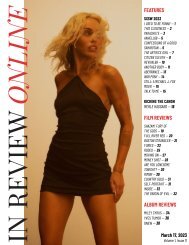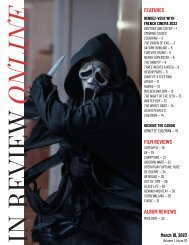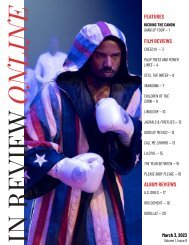InRO Monthly — October 2023
InRo Monthly
InRo Monthly
Create successful ePaper yourself
Turn your PDF publications into a flip-book with our unique Google optimized e-Paper software.
IN REVIEW ONLINE<br />
STITCHING REALITIES<br />
An Interview With Eduardo Williams <strong>—</strong> 1<br />
A CONTRACT WITH THE AUDIENCE<br />
An Interview With James Benning <strong>—</strong> 5<br />
NEW YORK FILM FESTIVAL<br />
Ferrari <strong>—</strong> 13<br />
The Beast<strong>—</strong> 13<br />
Maestro <strong>—</strong> 13<br />
Janet Planet<strong>—</strong> 13<br />
The Shadowless Tower <strong>—</strong> 14<br />
Trailer of a Film That<br />
Will Never Exist <strong>—</strong> 14<br />
La Chimera <strong>—</strong> 14<br />
Close Your Eyes <strong>—</strong> 14<br />
Ryuichi Sakamoto | Opus <strong>—</strong> 14<br />
We Don’t Talk Like We Used To <strong>—</strong> 14<br />
The Settlers <strong>—</strong> 14<br />
Bleat <strong>—</strong> 14<br />
KICKING THE CANON<br />
The Passenger <strong>—</strong> 15<br />
Lost in Translation <strong>—</strong> 18<br />
FILM REVIEWS<br />
The Exorcist: Believer <strong>—</strong> 21<br />
The Caine Mutiny Court-Martial <strong>—</strong> 21<br />
The Royal Hotel <strong>—</strong> 21<br />
The Burial <strong>—</strong> 21<br />
Foe <strong>—</strong> 21<br />
She Came to Me <strong>—</strong> 21<br />
Pet Sematary: Bloodlines <strong>—</strong> 21<br />
When Evil Lurks <strong>—</strong> 22<br />
My Love Affair With Marriage <strong>—</strong> 22<br />
Totally Killer <strong>—</strong> 22<br />
Once Within a Time <strong>—</strong> 22<br />
Dark Harvest <strong>—</strong> 22<br />
Anatomy of a Fall <strong>—</strong> 22<br />
Divinity <strong>—</strong> 22<br />
Dear David <strong>—</strong> 22<br />
Fair Play <strong>—</strong> 22<br />
Killers of the Flower Moon <strong>—</strong> 23<br />
The Delinquents <strong>—</strong> 23<br />
Onyx the Fortuitous and<br />
the Talisman of Souls <strong>—</strong> 23<br />
Silver Dollar Road <strong>—</strong> 23<br />
Pain Hustlers <strong>—</strong> 23<br />
The Pigeon Tunnel <strong>—</strong> 23<br />
Butcher’s Crossing <strong>—</strong> 23<br />
Boudica: Queen of War <strong>—</strong> 24<br />
The Holdovers <strong>—</strong> 24<br />
Suitable Flesh<strong>—</strong> 24<br />
Four Daughters <strong>—</strong> 24<br />
<strong>October</strong> <strong>2023</strong>
STITCHING<br />
REALITIES<br />
An Interview With<br />
Eduardo Williams<br />
Argentinian filmmaker Eduardo Williams’ new<br />
film The Human Surge 3, which premiered this<br />
summer in competition at the Locarno Film<br />
Festival, is his first feature since The Human<br />
Surge. But there’s no missing second part, nor is<br />
the film a sequel, at least in the sense that it<br />
doesn’t rely on having seen the first film <strong>—</strong> nor<br />
continue its plot. What the two films share is an<br />
international set of performers and shooting<br />
locations, though the characters in the new film<br />
move much more freely between settings. The<br />
film also shares a shooting style with Williams’<br />
2019 short film Parsi, which was recently<br />
available to stream on Le Cinema Club. Both<br />
films were shot with 360° cameras and then<br />
framed in virtual reality by Williams after he cut<br />
the film together. The result is one of the most<br />
energizing two hours of the year, featuring some<br />
of the most novel images in recent memory. We<br />
spoke to Williams during the New York Film<br />
Festival, where The Human Surge 3 had its U.S.<br />
premiere.<br />
When you made the first film, The Human<br />
Surge, did you start out thinking about that<br />
as a project that might continue over<br />
multiple films? Or was there something<br />
afterward that made it feel like it was a<br />
project you wanted to continue?<br />
I mean, when I did The Human Surge, I didn’t<br />
think about having another film with the same<br />
title. So, it wasn’t a project in that sense. But at<br />
the same time, I see all my films as quite<br />
continuous, you know, and as the same project,<br />
they are very connected. So for me, it’s not a big<br />
surprise. But then, when I was thinking about<br />
what film to do after, I had the idea of naming it<br />
The Human Surge 3 because I realized that many<br />
of the ideas were very continuous. I also thought<br />
it was interesting to also go a bit against [the<br />
idea of] the notion of a single human surge; [if<br />
you have a first human surge and a third human<br />
surge,] there seem to be many possible human<br />
surges, let’s say.<br />
1
What were the specific ideas carrying over from the first film<br />
that led you to want to use the name again?<br />
I think a very simple and basic thing was the idea of making a film<br />
in several countries, in different continents. So this idea of<br />
connecting countries and people that I<br />
don’t see connecting so often, that was the basic thing. And then<br />
probably similar things that I was thinking about naturally, about<br />
my life and about many people’s life, like moving, transporting,<br />
using technology, how that changes our way of seeing everything;<br />
our relation with nature, and with everything that’s nonhuman, and<br />
other things like friendship and work. So I think in this one, I wanted<br />
to say, “okay, we have the same worries about the working world,”<br />
but also I wanted to go a bit further into the fantasy <strong>—</strong> or at least try<br />
to. So that was what I saw in continuation and evolution from the<br />
other one.<br />
Coming from a math background, when we’re mapping<br />
three-dimensional space in terms of rotation [which is to say,<br />
in the context of film, panning,] we can do it as a sphere or as<br />
a cylinder. The cylinder is nice in some ways because it’s<br />
closer to how we map two-dimensional space rotationally;<br />
we’re just adding in the up and down movement, but you have<br />
the rough edges in the up and down directions. The sphere then<br />
solves that problem in that it’s smooth all over, but it can be<br />
harder to conceptualize [or, as the three-dimensional space of<br />
this film captured by the 360-degree camera and then<br />
represented digitally, to program.] There are moments in this<br />
film where you do include that area directly above and below<br />
the camera, which I’d imagine is not designed so much to<br />
capture, so I wonder when you were doing the framing in VR if<br />
you felt more like you were looking around a sphere or a<br />
cylinder.<br />
I think in my experience I felt more in a sphere than in a cylinder,<br />
though it’s true that when I take the sphere to the screen, maybe it<br />
turns a bit more into an open cylinder. And then a sphere, I don’t<br />
know. But it’s true that what the camera creates is a sphere. So we<br />
see the stitches and lines when we look in front, but when we look<br />
up and down we see like a flower or a star, you know, where the<br />
eight cameras get together. So yeah, it was less smooth. But as you<br />
see in the film, I really liked that. So I tried to look there on purpose<br />
[at times,] and also I was thinking about what types of images to<br />
put there.<br />
We have a very important moment in the film where the camera<br />
spins. So there was also a circular energy that came to me very<br />
intuitively, like this desire of looking around that came because I<br />
could do it with this camera. And then thinking about it, I think it’s<br />
an important thing to have as the film advances; we started looking<br />
around more. And then in the spinning thing, we try to leave or<br />
break the image, let’s say, through [stitching]; I really liked this star<br />
or flower that was formed [through the stitching], although I think I<br />
could have tried to make the stitching there better. I don’t know if I<br />
could have done it totally invisible, but I didn’t even try because I<br />
really liked to see the seams in there.<br />
And then just before this, we have a very short segment of someone<br />
sleeping, and I put the camera on top of the person so the face<br />
would be in the stitching point below, where the eight cameras<br />
come together. And I realized when I saw this in my iPad, which is<br />
the direct streaming image, that we saw three faces. And when I<br />
stitched it afterwards, in the computer, this was lost. So I kept this<br />
preview image, which is the worst quality that you can get, because<br />
I really liked the three-faced living person that I would have lost if I<br />
made a better stitching. And at another moment, near the<br />
beginning, we have one face that is right in the stitching of two<br />
cameras, which is not below or under. And I knew that if you put the<br />
face very close to the camera, the camera couldn’t stitch very well.<br />
So we lost part of the face. And I really like this feeling of people<br />
blending into the digital image. So I used this, and in the end I did it,<br />
but artificially, so I generated the same deformation in the face of<br />
another actress. And in the moment I made the other actors react<br />
to this because I wanted to have this feeling of, okay, at the<br />
beginning we think this is just a glitch in the camera. And then we<br />
realize the actors, or the people we see, can see it. You know, we<br />
thought they couldn’t, but now we see they can.<br />
I have a couple of questions about the framing of the film and<br />
the post-production in VR. First, specifically in the scene you<br />
were talking about with the spinning, did you have to stand in<br />
the middle of the room and spin in a circle? Or is there just a<br />
button that you press and the image spins? And then more<br />
generally, how much time did having to do the framing, as well<br />
as the editing, during post-production add to the process?<br />
The spinning I made on the computer first, while I edited the two<br />
hours [of the film]. But it’s super fast, I couldn’t have spun so fast,<br />
so I added movement <strong>—</strong> I had the spinning already happening in the<br />
VR, but I added movement to that, slower movement, but still. I<br />
2
Something that I noticed both watching The Human Surge 3 and<br />
Parsi is this: when I’m watching a movie with subtitles <strong>—</strong><br />
whether it’s a movie in English where I just happen to have<br />
them on or a movie not in English where I need them to<br />
understand the dialogue, or when there’s a lot of overlapping<br />
dialogue (like in your films) <strong>—</strong> I’ll often see the subtitles pick<br />
out pieces of that dialogue so that it’s a reasonable amount to<br />
read. And I really like that the subtitles to your films embrace<br />
the chaos of the overlapping dialogue, such that all of the<br />
dialogue being spoken in the scene is on the screen for you to<br />
see, even if it’s more than most people could read. Do you take<br />
a really active role in doing the subtitling?<br />
3<br />
wanted to try to connect this computer movement to a more<br />
organic one. It’s a bit subtle, but I think it added something.<br />
And then how much time… I don’t know exactly how much time<br />
because really, I was doing everything at the same time. So while I<br />
was editing the sound, I was still framing. Also, after each shooting,<br />
I edited without the VR first because I couldn’t solve the problem of<br />
how to record my movement until the end. I mean, for Parsi<br />
[Williams’ previous film shot with a 360° camera] I could do it<br />
myself, but it was with a GoPro. So the image was easier for me [to<br />
work with] on my normal computer, and I just screen-captured the<br />
computer. But here I didn’t want to lose so much quality, so it was<br />
difficult to handle it on my own. So afterwards, we had a fund and<br />
we went to India to a post-production company called Media.Monks.<br />
And they made the system in Unreal, which recorded my movement<br />
and gave me keyframes that I could put in the good-quality image<br />
(because in the headset, you really cannot see these images in good<br />
quality). So I don’t know how much time it added; I would say maybe<br />
a month. I mean, I went for a week to India. And there they gave me<br />
the system in Unreal on a computer, and I could travel with that<br />
while I was doing the other post-production parts. It was very<br />
intense, working every day all day for almost a month: waking up,<br />
[working on the] computer until I fell asleep, and then again. It was<br />
also intense because I always try to do post-production a bit fast. I<br />
like to feel a bit of pressure about time.<br />
Yes, absolutely. For me, these moments are super important. As we<br />
know, translation can be very different. I mean, even if it’s the<br />
“correct” translation, you always have options. And sometimes for<br />
subtitles, you need to be more concrete [about your decisions];<br />
maybe you need to be shorter if you can while maintaining the<br />
same meaning. So it’s important for me to choose in which way [the<br />
dialogue is translated,] at least for the English subtitles; then for<br />
the other languages that I don’t know, I cannot. It was a very special<br />
thing to think about. At the beginning, I translated everything. But<br />
even if I liked the overlap there was too much. I mean, one of the<br />
reasons for doing that was that I thought if the spectators feel it’s<br />
too much to read then maybe I would invite them to stop reading<br />
for a while. I did the same thing in Parsi, in the moments where we<br />
have the poem and the dialogues of the people we see, but we can<br />
physically not read everything. So I was trying to say this here as<br />
well. Of course, some people still read all of it; it depends on your<br />
personality, how much you can not care about it or if you feel you<br />
really need to read. But I felt I had to reduce it a little bit, because it<br />
was maybe too much. I mean, I tried for it to be too much, but not<br />
so much, I don’t know [*laughs*]. So if you understand one of the<br />
languages, you can get a bit more, but it doesn’t change radically. I<br />
still try to keep, like, the general meaning of the conversations they<br />
were having. I just maybe took one or two phrases out to make it a<br />
bit less crazy.<br />
Yeah, and I think it works really well at emulating what the<br />
experience would be like if you understood one or more of the<br />
languages being spoken, and while at a certain point you pick<br />
up some of the meaning, the actual sound of the combined<br />
voices becomes just as important.<br />
Yeah, for me too.
I think with these emerging technologies like VR and 360°<br />
cameras we’ve seen a lot of technical demos, but there haven’t<br />
been a lot of users with the express goal of making cinema or<br />
art. Are there more ideas with these technologies you’d be<br />
interested in continuing to explore, or other new technologies<br />
you’re interested in employing?<br />
I mean, as you say, the most important thing for me about using<br />
these technologies was how I used them and why. And there were a<br />
lot of reasons with this film, but one main reason relates very much<br />
to a basic question we have in cinema, which is how to frame <strong>—</strong><br />
how we decide the frame of <strong>—</strong> a film. So in this case, I was moving<br />
the moment of the decision from the shooting to post-production.<br />
And also changing the state of mind [I was in]; you’re not in the<br />
same state of mind during shooting as in post-production, sitting<br />
alone in a room with time dedicated only to watching the images.<br />
So for me that’s the important thing, it’s not about technology so<br />
much as just how you use tools to think in a different way.<br />
But going forward, I’m not really sure. I have an idea <strong>—</strong> a very loose<br />
idea, I’m not exactly sure what I want to do next <strong>—</strong> but it doesn’t<br />
relate so much to a new technology as much as maybe a type of<br />
lens I’d like to use. In my mind, my ideal would be going back and<br />
forth, maybe using film and thinking if I’d use it in a different way<br />
now that I have all this experience working in virtual reality. In The<br />
Human Surge I used 16mm film as well as a small and a big video<br />
camera, and for me the idea was how would I use film with the<br />
mind of someone who watches YouTube videos as well as<br />
conventional films. In my mind that’s the question: how do we use<br />
both old and new technologies in the present?<br />
In my mind I won’t use VR and a 360° camera next, although maybe<br />
something happens and I change my mind. With Parsi I didn’t know I<br />
wanted to use VR, I just knew I needed a small cheap camera, and I<br />
started googling what are the small cheap cameras I could get, and<br />
then I saw the GoPro 360, and I wanted to use it because it was a<br />
good way of being able to give the camera to the actors without<br />
them having to think about framing. So the next time I’m working<br />
on a new project, I’ll probably also look on the Internet to see what I<br />
might be able to use.<br />
Have you gotten any opportunity since you started working<br />
with the 360° cameras to do more traditional work and see how<br />
your approach to that has changed?<br />
Not really. I made one installation for a museum called A Very Long<br />
.GIF, but that’s with a pill camera which isn’t traditional at all,<br />
though it’s also with a tele lens, which is more traditional <strong>—</strong> I like<br />
that combination of looking in our bodies and looking very far,<br />
within the same video. I’m not sure if it’ll really change or not, but<br />
it’s a curiosity I have. <strong>—</strong> INTERVIEW CONDUCTED BY JESSE<br />
CATHERINE WEBBER<br />
4
A CONTRACT WITH THE AUDIENCE<br />
An Interview With James Benning<br />
James Benning, the legendary moving-picture artist known for his durational portraits of America, has made one of his most personal<br />
works yet. Shot not too far from the cabins the artist reconstructed for his Two Cabins, Allensworth contains only twelve shots of a<br />
reconstructed version of California’s first town founded and run entirely by Black people that, years later, met an unjust end. Though a<br />
formal description may make Benning’s work seem simple <strong>—</strong> just as his Ten Skies (2004) might be described as “ten skies” <strong>—</strong> each minute<br />
spent with the work encourages the cogs in the viewer’s mind to turn on their own, allowing them to notice details that other filmmakers<br />
would’ve cut away from or to ponder the image’s relationship with the political history that birthed it.<br />
Benning himself notes in this interview that his simple approach forces a more engaged style of viewing <strong>—</strong> something quite rare in an age<br />
of political movies that opt for condescending exposition. Paying attention is good for both politics and art, so we talked to James Benning<br />
about both during his time at the New York Film Festival.<br />
You've been a teacher longer than you've been a filmmaker. Have you noticed a big difference recently in how different<br />
generations might approach art or what you teach?<br />
5
Oh, that's a really hard question. I've been making films for over 50<br />
years, so certainly it changes from day to day almost. When I<br />
began, I was connected to an avant-garde experimental film world<br />
influenced by Michael Snow and Hollis Frampton and less<br />
influenced by people like Brakhage, who made things that were<br />
more lyrical.<br />
I was more interested in the conceptual use of film. And now I'm<br />
very far away from that beginning. I'm kind of rooted in<br />
structuralism from the '70s, but I'm maybe more interested in the<br />
content that I'm putting in the film. And as far as students over the<br />
years, sure they've changed, just kind of like me, because the whole<br />
film world has become much wider, and I embrace the art world<br />
now more than the film world, so I tend to get students that are<br />
doing the same. So the kind of students I get today are almost the<br />
exact opposite of what I began with, and they're interested in those<br />
issues that are in the art world.<br />
I suspect that there's a little bit of self-selection with some of<br />
your students, though. That they might know what's going on if<br />
they choose to do a class with James Benning.<br />
Yeah, it's true, but we, at CalArts, tend to choose a lot of graduate<br />
students that maybe haven't even made films yet, that they're in<br />
the art world, or maybe they study mathematics, or history, but they<br />
have an interest in kind of expanding the film vocabulary. So, I tell<br />
them I don't want them to make another good film. We've had way<br />
too many of those. I'd like them to push the vocabulary and add to<br />
the film language. Which is a big challenge.<br />
Yeah, that's probably the best class I've ever taught. I continue to<br />
teach that, although it's getting more difficult because I'm not as<br />
mobile as I used to be. But I teach a variety of other classes that I<br />
enjoy, too. I teach a class called “Acting Bad,” where we deconstruct<br />
acting. It leans toward a kind of performance art. And I'm teaching<br />
a class on installation design this fall to allow students to design<br />
installation work without worrying about the amount of equipment<br />
they can get access to and the money. And then to pare down these<br />
kinds of grandiose proposals into something that's usable. So, this<br />
is a new class, and we've only taught it for two, three weeks now.<br />
But it seems like it's gonna be valuable.<br />
Do you think patience has declined thanks to the rise of things<br />
like smartphones, or kind of a constant stimulation? Do you<br />
think patience can be taught, either at a university level or just<br />
throughout one's lifetime?<br />
Well, I talk a lot about that, and I think through observation one<br />
gains agency. And I think just by talking about that concept that we<br />
can learn in different ways. You know, a mother can tell us<br />
something to do, or a cop can tell you what to do. You can read a<br />
book or whatever, but you can also look and listen.<br />
And that's really hard work. First, you have to even know you can do<br />
that to learn that it's an option of learning. And then once you know<br />
that, then you need to practice because it's a discipline to stay<br />
focused and to look at something for an hour to see how the light<br />
changes or to contemplate what are the social and political<br />
implications of a space.<br />
I'm curious if you've also noticed any kind of big bureaucratic<br />
changes that have taken place whenever it comes to teaching<br />
something like art or film.<br />
Like the outside world, everything is becoming morbid, and even in<br />
CalArts, which is a private school, those structures become<br />
top-heavy with administration. And it's only damaged the kind of<br />
freedom that I instill in students, you know. And then there's a lot of<br />
concern about lawsuits and providing students with information so<br />
they don't get into trouble. And I think to make good films, you<br />
almost have to get into trouble. So it's kind of a conflict.<br />
Do you have any favorite classes that you're teaching<br />
nowadays? I know you have that legendary "Seeing and<br />
Listening" class that everyone brings up.<br />
And then you can look things up and, you know, the actual<br />
observation can give you ideas as to which direction it goes. But, I<br />
think we're very far away from that because of the cell phones and<br />
things that are always distracting us. We have to have such<br />
discipline. The phone makes us look at it constantly. I don't have<br />
one, because I'm afraid I would just do that all the time. It is a trap.<br />
Friends of mine and myself <strong>—</strong> a lot of times we’ll select to go to<br />
movies in theaters simply because it can be so hard to watch<br />
movies or to engage with art at home with those distractions.<br />
But the theater has developed a contract with the audience that's<br />
stronger than real life. I can have a 10-minute shot of the moon<br />
rising, and people sit there and watch it. And, because they know<br />
when you come here, you actually do observe. But to get somebody<br />
6
to watch the moon rise outside for 10 minutes, they'll be looking at<br />
something else. You know, it's hard to stay focused. And it's an<br />
interesting thing now with installation art and installing films: that<br />
contract is much looser than the contract with the theater<br />
audience. So, that has to be developed too. Although, I think<br />
galleries and museums are perhaps much more social than viewing<br />
a film. So you go there to have a cup of coffee and you spend time<br />
<strong>—</strong> ten seconds <strong>—</strong> in front of each painting, and, you know, that<br />
contract has never been defined very strongly. But I think there are<br />
attempts now by artists and gallerists and museums that when you<br />
install work that has durational components, that somehow you<br />
have to allow the audience to know this is durational and you won't<br />
get it if you just watch it for 10 seconds.<br />
To get the people to do that is another thing. Now, I have a<br />
particular following, so if I do installation works, I'll get some of the<br />
people that know my films, knowing how to watch them. Others can<br />
be very difficult.<br />
How would you arrange the space in order to maybe<br />
communicate to somebody who wouldn't know your work that<br />
it would be durational? My first thought would be something<br />
like hiding it around a corner. I've seen museum installations<br />
where you hide a work around a corner and it's its own private<br />
space outside of the rest of the museum where you can engage<br />
with the art and leave on your own contract or will.<br />
Well, I don't really have an answer yet for that. But one is to just be<br />
straightforward and say this piece begins every hour on the hour,<br />
and it's durational and it lasts 45 minutes. Oh, and then it's also to,<br />
as when you build installations, consider this lack of contract and<br />
make work that can be seen just walking by.<br />
And then when they walk by another time, something else is<br />
happening. I've installed my film Twenty Cigarettes, and there it is<br />
without any explanation. And it's nice if it's at the beginning of a<br />
gallery space or museum. Because somebody will come in and<br />
7
there will be somebody smoking. And they might just see that same<br />
person and they walk around and they can pass it again and<br />
somebody else is smoking and then they look at it and then they<br />
come back. And then once you realize, oh, there's a number of<br />
people <strong>—</strong> maybe it draws you into it. But if I want an audience to<br />
actually experience it like in a theater, then I would have to have<br />
some kind of statement saying, you know, it starts at this time.<br />
So, one can have the different expectations of the installation: that<br />
you can have it so people actually watch it as a film, but then why<br />
not have it in the theater anyways? Or you can live with how it's<br />
viewed without any explanation. When I've installed [it like] that, I<br />
didn't expect people to watch the whole thing. I kind of like the idea<br />
that if it's near the end or beginning, people would pass it going in<br />
and out and see somebody else.<br />
Location is obviously a very important part of your work. I'm<br />
curious as to what your pre-production research process might<br />
be whenever you decide to film on a new location, and whether<br />
or not that varies whenever you're doing a project that's very<br />
specific to one location, like Allensworth, or perhaps something<br />
like North on Evers or The United States of America, where it's a<br />
much broader portrait.<br />
Yeah, it varies from film to film. I mean, the remake that I made of<br />
the U. S. A. that Bette Gordon and I made in 1975 was just crossing<br />
the U. S. with shots occasionally taken from the back of a car. And<br />
it played on one of <strong>—</strong> I can't remember, it was on streaming for a<br />
while [note: The United States of America briefly streamed on The<br />
Criterion Channel] and it got a great response.<br />
And then I thought, oh, I'll remake the film, but not really remake it.<br />
And then I just used the same title again. And for that, it was during<br />
Covid and I thought, well, I want to make a film that represents the<br />
whole U. S., but I don't want to travel that much during Covid, but I<br />
do want to get out of the house.<br />
8
And I know California worked very well, so I'll shoot everything in<br />
California. It'd be kind of a playful joke, and I reveal that at the end.<br />
But also, I thought it spoke to other things. How Hollywood movies<br />
do that all the time <strong>—</strong> where they are and where they're shooting.<br />
And then it became a kind of a fun project for me to find in<br />
California to represent Georgia, for instance.<br />
And then I realized that at one end of the county are my replicas,<br />
and then at the other end of the county there's this state park now<br />
that's replicated the town of Allensworth. So all of a sudden, my<br />
project was connected with that. And then it connected with my<br />
interest in how I've been fighting against the kind of prejudice that I<br />
grew up with.<br />
9<br />
Do you think that work has an anthropological element to it? I<br />
mean, it's mostly landscapes, but I feel like every once in a<br />
while we do see people and different kinds of people creating<br />
different kinds of environments.<br />
Well, Allensworth is a town that was built in the early 1900s in Tulare<br />
County, and it's in the Central Valley, which feeds a third of the U. S.<br />
with large corporate farms. And that happened after Allensworth<br />
was started in the early 1900s. And I was interested in that<br />
particular place because I'm interested in the evils of white culture<br />
toward Black culture.<br />
I grew up in a poor white ghetto in Milwaukee that was adjacent to<br />
the small Black ghetto. And I was being taught to hate Black people<br />
and that Black people hated us. We didn't know each other, but we<br />
did apply for the same job. So it was an institutionalized way to<br />
keep labor costs down and to keep the fighting in the poor part of<br />
town. So that took me some time to understand, that kind of<br />
systematic prejudice that I grew up in.<br />
So I've been trying to rid that from my system my whole life. And<br />
then when I found out about Allensworth, a town that had great<br />
promise, only it couldn't succeed mainly because of that [system].<br />
The way white culture made it very difficult for them. The land itself<br />
was sold to the Black people that were trying to start the town at a<br />
cost that was three times the rate of good land.<br />
And this was really poor land. And then the train was moved from<br />
their place to the close-by white town, so they lost that kind of<br />
revenue and distribution. And it goes on and on. They didn't get the<br />
water that they were promised when the irrigation systems were<br />
set up.<br />
In the end, the town fails. And then the town was rebuilt as a park,<br />
and that interested me because I have a place in Tulare County at<br />
the other end of the county that's up in the mountains. That’s where<br />
I built replicas of Thoreau's cabin and Kaczynski's cabin. So I have<br />
this as a kind of questioning of outsider-ness.<br />
So that all kind of connected and made me think, well, I'll just look<br />
at this place and see what I can learn from observing it. I thought of<br />
it as a mystery film where I wouldn't tell you anything about it. You<br />
would just observe it as if you stumbled onto this place. And then,<br />
through certain hints through sound and performance and poetry, I<br />
would give enough hints that you could kind of figure out what you<br />
might be looking at. And then in the end credits, there's a little more<br />
information. But hopefully, because everybody has these devices,<br />
they can look at it and can type in Allensworth and learn. So the film<br />
is a mystery film that gives you hints as to what it is, but it doesn't<br />
really completely describe it. But you can quickly find that<br />
information out. It's online, and now I've drawn great attention to<br />
that place. And to this event <strong>—</strong> the whole history of Allensworth.<br />
And it was a hidden history. So I'm hoping that the film does some<br />
teaching in that respect. But it doesn't do it itself. You have to be<br />
proactive and react to the film. And I think most people do that. And<br />
now it's got many reviews, and I'm really surprised. I was really<br />
pleased that almost everybody reviewing the film did extensive<br />
research about the place, and it's exactly what I wanted the film to<br />
do, so I think it's very successful in those terms.<br />
That's pretty good that you can have that secret pedagogy<br />
there to give them just enough information so that they want to<br />
learn more and teach themselves.<br />
That'd be the best way to do it. Otherwise, if I watch documentaries<br />
and they solve all the problems, I seem to think, okay, I know that,<br />
and then I never think about it again. So I have this opinion that<br />
documentaries should kind of motivate you. Some kind of activism.<br />
Be a participant within the film.<br />
How did you first come across the story of Allensworth? I was<br />
also going to ask how far it is from Val Verde, but it seems like<br />
it's closer to your cabins.<br />
Yeah, and it's not on the way between Val Verde and Pine Flat where<br />
I live at the moment, but it's directly west of the road that I go up<br />
into the mountains. When I come back down, if I don't turn on the
65 and keep going, I run right into Allensworth. So, my Two Cabins<br />
project is in a direct straight line with Allensworth. I stumbled on it<br />
just riding around Central Valley. I didn't know about it when I made<br />
El Valley Central.<br />
And then I stumbled across it 20 years ago. It happened to be on<br />
the day of the year that they celebrate the founding of it. So there<br />
were maybe 60 or 70 Black people there, and they were giving<br />
speeches, and I think there might have been one or two other white<br />
people at the time. So I was really surprised <strong>—</strong> it was an accident,<br />
basically.<br />
But then I didn't think about doing anything about it until so many<br />
years later after I had built my cabins, and then at some point it<br />
occurred to me: Oh, this fits exactly into what I've been struggling<br />
with my whole life. And so I've always been prepared to be kind of<br />
attacked by, I don't know, liberals I guess, that would say, oh, what<br />
right do you have to talk about Black people? But I'm not talking for<br />
Black people. I'm pointing the finger at the poor way white people<br />
act. So that's my interest: to point out these kinds of mistakes and<br />
how evil it is and what it can lead to.<br />
You say the town is a park now. So is there even a town that is<br />
operational and running?<br />
The park itself, no one lives there. And it's very spooky, and you kind<br />
of get that feeling from the film where you see one or two people in<br />
the whole film, and they're kind of hidden.<br />
The park is about two-thirds of what the town was. And so, south of<br />
the town, there's part of the [original] town, then there's a grade<br />
school there, and there's maybe 20 houses, and it's mainly, I think,<br />
Mexican at this time; maybe there's a few Black people. The<br />
graveyard is on the other side of that town <strong>—</strong> so the graveyard in<br />
Allensworth is outside of the park; it isn't part of the park, and it<br />
hasn't been restored. And it hasn't even been researched to figure<br />
out who's even buried there. It's just falling apart at this time.<br />
And I've gone there a number of times and I've met one of the Black<br />
10
11<br />
families that live in that part of Allensworth. And they were trying to<br />
raise money to do research to find out who is there and, at least,<br />
put it back into some kind of shape. But, it's still being used. There<br />
are a few graves that are only five or six years old there. But most<br />
of them are just little wooden crosses, no indication of who's buried<br />
there.<br />
The “December” shot in your film almost looked like a set,<br />
because the gravestone is still pretty legible, and then the<br />
crosses are set up in no order.<br />
And in the background of that shot, you can actually see some of<br />
the houses that are in the livable part of the town. But they're at a<br />
distance. And I think you hear a dog barking from there. And a plane<br />
flies overhead.<br />
Did you have to ask permission from the Parks Department? Or<br />
did you just show up and start filming?<br />
Well, the park is interesting, because I got stopped a few times. And<br />
the other interesting thing: the people who administer the park are<br />
all white. So, you know, it just continues on. They asked me what I<br />
was doing, and I just said that I'm interested in the place and I'm<br />
making a film to show my friends, you know.<br />
I showed the film at the Academy Museum in L. A., and there was a<br />
Black man who came to that screening that's connected with a<br />
group of Black people who are trying to have some say in<br />
Allensworth. And he liked the film a lot, and he wants me to show it<br />
at one of these yearly events there. So I'd like to do that.<br />
There are a couple of shots in this that I think are what you're<br />
referring to as these hints as to what is going on here. One is<br />
the big “August” shot with the student reading Lucille Clifton<br />
poetry where she's dressed like Elizabeth Eckford of the Little<br />
Rock Nine. And then you also have two songs: one's by Lead<br />
Belly, the other one Nina Simone. Was there anything that led<br />
you to those particular choices? Or did you want to just have<br />
some sort of rhyming with the bigger project of talking about<br />
Allensworth?<br />
Well, the two artists <strong>—</strong> I respect their work, and their own histories<br />
are interesting. Nina Simone is somebody who fled America<br />
because of racism, and that song is kind of brutal. So I thought it<br />
states what I'm interested in, the result of this kind of racism. And<br />
then Lead Belly <strong>—</strong> somebody who was let out of prison because he<br />
could make some music, and then had a song that Kurt Cobain<br />
made more famous than him <strong>—</strong> so it's this idea of Black culture
eing appropriated by white. He doesn't make money from it. So, I<br />
mean, I don't know if people watching it think about that, but it's in<br />
the film, it's something we can talk about.<br />
Also, the quality of the buildings themselves <strong>—</strong> and I'm guessing<br />
this has to do with the fact that it is a park now. They do look<br />
old, but they certainly don't look like they're from 1912.<br />
The choice to dress a student like Elizabeth Eckford <strong>—</strong> it's a<br />
very particular kind of outfit.<br />
I was very young when that picture was in the newspaper, and I was<br />
appalled by it. And that was kind of a beginning for me to start<br />
questioning. Because I could relate to this kid as a student, but I<br />
couldn't relate to going to high school the first day and having such<br />
stress, you know. And I thought, oh, this is what my neighborhood<br />
brings about, this kind of evilness.<br />
They were built from 1975 to '85. So they are like 40 years old and<br />
look like that. And some of them had just maybe been repainted a<br />
few years ago. Others, I’ve noticed they're repainting a lot of them<br />
this year. So it looks more like a park. Also, there’s the park rule<br />
about having wheelchair access. I had to try to shoot so I didn't<br />
quite show all the ramps that are in the place. And the interiors are<br />
all furnished with not the exact furniture that was in there, but of<br />
that period and that place. But, you can look in the windows, and<br />
once a year, I think they open the doors.<br />
So it's a reference to my own coming of age, kind of. But also, that<br />
photograph is kind of the quintessential meaning for what I've been<br />
struggling with my whole life. And it's such a beautiful dress. And<br />
that's such a tragic story for her because her family didn't have a<br />
telephone and the other eight students were alerted to enter the<br />
school from the back door, and she wasn't told. The information<br />
didn't get to her, so she was by herself confronted by this.<br />
I mean, I also feel bad for poor whites that, even today, a lot of<br />
Trump followers, when you have nothing, then you can be so easily<br />
manipulated. So it's kind of also a portrait of madness, that we have<br />
to look beyond who's actually yelling.<br />
I'm also curious about the structuring device of the film. It's<br />
separated into different months, but I think there's something<br />
interesting about that particular part of the California<br />
landscape. I suppose I was trying to look for the changes in<br />
maybe the flora or something. But I think the biggest visual<br />
indicator that the months are changing is maybe just the<br />
quality of light coming through.<br />
Yeah, California's upside-down because it's green in the winter and<br />
it's brown in the summer. So, in the very first shot, there's frost on<br />
the ground and there's actually green grass, but it's very muted<br />
because there's not much light. It's foggy that day. And then the<br />
next three or four shots are where you can see the grass getting<br />
greener in February, etc. And then by September, it's yellow, so it's<br />
the opposite. And there's not a lot of rain there. The rainy season is<br />
generally in the springtime. And so I had some cloudy days, but it<br />
was unusual for me to find it raining in <strong>October</strong>. But I took what I<br />
got.<br />
I took pictures through the window of the school and then I<br />
actually recreated the blackboard and the wainscoting exactly. So I<br />
made a replica of a replica, and shot it at school where I could have<br />
more control over things and didn't have to get permission to go<br />
inside.<br />
With digital technology developing so quickly and all kinds of<br />
new equipment coming out, do you find yourself trying to keep<br />
up with that <strong>—</strong> trying out new equipment and whatnot? Or do<br />
you have some standard digital tools that you like?<br />
Yeah, I shot on 16mm from 1970 to 2007, and I used two Bolexes: one<br />
was a hand-cranked Bolex, the other was an electric one that I put<br />
in a 400-foot magazine so I could do 11-minute shots. And I got<br />
familiar with that equipment and I liked it, and then it became<br />
impossible to get good lab work and I was forced into digital. I<br />
didn't go in until there was high definition digital.<br />
And so I bought a Sony camera in 2009, and it's just HD <strong>—</strong> I don't like<br />
4K. I’m still shooting HD because I don't like that ultra sharpness. 4K<br />
is great for if you're shooting at night or in darkness; you can get<br />
good quality in darker settings. But for what I do, I'm very happy<br />
with just HD, just the 1920x1080. I'm not trying to make films, but I<br />
think Allensworth almost looks like 35mm. It has kind of the same<br />
resolution. It isn't as sharp as 4K. I won't change that camera. I'm<br />
trying to keep it alive. So I've shot, I don't know, more films with that<br />
in 15 years than I shot [with the Bolexes] in 35 years. It's so cheap,<br />
and I made Allensworth for, I don't know, a thousand dollars. And<br />
that's just mainly gasoline. <strong>—</strong> INTERVIEW CONDUCTED BY ZACH<br />
LEWIS<br />
12
FERRARI<br />
Michael Mann<br />
“Perhaps Mann is attempting to find a<br />
more natural approach to shooting a<br />
digital period piece, one that flattens its<br />
inherent contradictions rather than<br />
heightening them, Public Enemies-style.<br />
Still, there are moments when the film<br />
feels like Mann simply and<br />
uncharacteristically transplanting his<br />
script to the screen. The images and<br />
textures captured by his 21st-century films<br />
aren’t just incidental <strong>—</strong> they’re the very<br />
essence of his cinema, invigorating and<br />
investigating his scripts at every turn, and<br />
Ferrari becomes somewhat more<br />
conventional in losing them.” <strong>—</strong> BRAD<br />
HANFORD<br />
THE BEAST<br />
Bertrand Bonello<br />
“Premonition, made sublunary thus, is<br />
proclaimed over in Bonello’s daringly sci-fi<br />
tour de force… What Bonello realizes so<br />
radically throughout these interwoven<br />
periods is how the malaise of the present<br />
forever haunts its visions of the future,<br />
just as how the future has always arrived,<br />
is always the age of unattainable nostalgia<br />
for the light. With stylistic precision and<br />
visual panache, he fashions a haunting<br />
metaphysical reverie of the human soul,<br />
condemned to meaning it cannot<br />
decipher.” <strong>—</strong> MORRIS YANG<br />
MAESTRO<br />
Bradley Cooper<br />
“Cooper attempts the high-wire act of<br />
appealing to the living children of his<br />
subjects (i.e., the estate), while also<br />
depicting Bernstein honestly and artfully,<br />
but he’s ultimately undone by this<br />
challenge, falling into a number of<br />
biopic-specific traps along the way<br />
(clumsy expository dialogue, undermining<br />
dramaturgy in favor of chronology, etc.).<br />
Maestro isn’t a totally starry-eyed<br />
depiction of Bernstein by any means, but<br />
the way it apologizes for and redeems<br />
him… feels unsatisfying and evasive, and<br />
at odds with what Cooper seemed to be<br />
angling for.” <strong>—</strong> M.G. MAILLOUX<br />
JANET PLANET<br />
Annie Baker<br />
“By and large, Baker avoids rendering<br />
objects with pat allegorical import. For<br />
example, the small figurines and detritus<br />
that dot the tiny stage in Lacy’s room are<br />
mementoes in the constructed play of her<br />
memory. Indeed, the image of a child<br />
overlooking ‘the little world’ of the stage is<br />
redolent of nothing less than Ingmar<br />
Bergman’s Fanny and Alexander. Baker<br />
earns the comparison without resorting to<br />
facile pastiche, as the film’s climactic<br />
moment also incorporates an enigmatic<br />
disappearance that teases the outer limits<br />
of magical realism without breaking its<br />
own inimitably cast spell.” <strong>—</strong> NICK KOUHI<br />
13
THE SHADOWLESS TOWER<br />
Zhang Lu<br />
“while Gu is central to the film narratively<br />
speaking, the true geographical center of<br />
[the film] is the White Pagoda, a<br />
13th-century structure that, it is said,<br />
casts its shadow many miles away in<br />
Tibet, but leaves no such impression in<br />
Beijing. This architectural anomaly speaks<br />
to the complicated place of Buddhism in<br />
the People’s Republic, but Zhang, even<br />
more than this, allows it to serve as a<br />
looming metaphor for a solitary life, for<br />
people who <strong>—</strong> for whatever reason <strong>—</strong><br />
refrain from making their presence felt in<br />
the lives of others. <strong>—</strong> MICHAEL SICINSKI<br />
TRAILER OF A FILM THAT<br />
WILL NEVER EXIST<br />
Jean-Luc Godard<br />
“The existence of the new Trailer For a<br />
Film That Will Never Exist: Phony Wars<br />
presents, then, a confounding (if<br />
extremely beautiful) object <strong>—</strong> a<br />
fragmented preview of a larger work that<br />
will never come to fruition, a suicide note,<br />
a communique from beyond the grave. <strong>—</strong><br />
DANIEL GORMAN<br />
LA CHIMERA<br />
Alice Rohrwacher<br />
“La Chimera is powered by such cycles of<br />
excavation and potential rebirth, during<br />
which Rohrwacher’s approach constantly<br />
shifts, jumping between three shooting<br />
formats and corresponding aspect ratios…<br />
and throwing in direct address and scenes<br />
of sped-up motion that resemble silent<br />
comedy. The effect is one of instability,<br />
where everything about Arthur’s situation<br />
feels tenuous, most of all his mercurial<br />
nature and wavering feelings about his<br />
profession, exacerbated<br />
by a potential new love in the<br />
suggestively-named Italia (Carol Duarte). <strong>—</strong><br />
RYAN SWEN<br />
CLOSE YOUR EYES<br />
Victor Erice<br />
“Close Your Eyes treats mise-en-scène in a<br />
way that allows the natural flow of the<br />
actors’ rhetorical abilities to play a crucial<br />
role in enhancing the whole of the film’s<br />
beguiling atmosphere. Utilizing plenty of<br />
various materials, from books to<br />
photographs, archival footage to movie<br />
posters, and even a couple of songs that<br />
assist Miguel’s (personal) investigations<br />
along the way, Erice’s unique visual<br />
regimen and tranquil narrative<br />
distributions embrace a very specific<br />
archeology of the past.”<strong>—</strong> AYEEN<br />
FOROOTAN<br />
RYUICHI SAKAMOTO |<br />
OPUS<br />
Neo Sora<br />
“Ryuichi Sakamoto | Opus achieves a<br />
similar phenomenological effect as light<br />
and shadow subtly morph the composer’s<br />
gaunt features and slender fingers.<br />
Watching Sakamoto play arpeggios, I was<br />
reminded of my own father playing the<br />
piano and subsequently seized with<br />
emotion. This empathic recognition of<br />
Sora’s haptic engagement with his father<br />
through his camera only enriched my<br />
appreciation for the artistic equilibrium<br />
achieved between both filmmaker and<br />
subject. <strong>—</strong> NICK KOUHI<br />
WE DON’T TALK LIKE WE<br />
USED TO<br />
Joshua Gen Solondz<br />
“We Don’t Talk Like We Used To proceeds<br />
with the manic energy of one recognizing<br />
FESTIVAL COVERAGE<br />
in the world what was previously known<br />
via instinct. If it’s a redoubling of his<br />
strategy, rather than a reinvention, it<br />
raises the question of post-pandemic art<br />
to the level of urgency. Covid didn’t reveal<br />
anything especially novel about society,<br />
but it did make pre-existing<br />
contradictions impossible to ignore. <strong>—</strong><br />
DYLAN ADAMSON<br />
THE SETTLERS<br />
Felipe Gálvez Haberle<br />
“A lush, elemental reckoning unfurls across<br />
the relatively condensed runtime of Felipe<br />
Gálvez Haberle’s debut, The Settlers, even if<br />
few of its proceedings strictly qualify as<br />
terse. In fact, the film’s tersest narrative<br />
developments are matched by a formal<br />
languor which, enveloping the<br />
mountainous landscapes of Patagonia<br />
alongside its portraits of fin de siècle<br />
colonialism, conjures the phantasmic<br />
imprints of a history hastily realized and<br />
therefore not quite resolved. <strong>—</strong> MORRIS<br />
YANG<br />
BLEAT<br />
Yorgos Lanthimos<br />
“If the spiritual dimensions of Bleat feel<br />
overly calculated, that may be because<br />
Lanthimos is a filmmaker who’s more<br />
comfortable in the realm of the senses.<br />
Goats aptly abound throughout the film,<br />
occupying a metaphorical parallel to the<br />
human figures driving the wisp-thin plot.<br />
Their presence calls attention to the<br />
peculiarity of human behavior, yet the<br />
brutal fate of one poor bovid seems<br />
distinctly informed by a vestigial echo of<br />
Greek antiquity. In this respect, Bleat<br />
yields a flash of historical specificity that’s<br />
refreshing in the wake of the director’s<br />
burgeoning overreliance on anachronism.”<br />
<strong>—</strong> NICK KOUHI<br />
14
KICKING THE CANON<br />
THE PASSENGER<br />
Michelangelo Antonioni<br />
Michelangelo Antonioni’s endlessly digressive Blow-Up (1966), the<br />
Italian director’s first of four films produced outside his home<br />
country, features a particular digression that links it directly to his<br />
final international production, The Passenger (1975). Blow-Up’s<br />
central character, Thomas, is a hot-shot fashion photographer<br />
living a materially successful but emotionally unfulfilling life in<br />
Swinging Sixties London. His dissatisfaction has many sources, but<br />
he <strong>—</strong> in a particularly unpredictable moment <strong>—</strong> links his emotional<br />
sickness to disdain for his job. He wants to escape (fashion)<br />
photography’s vanity; to, in his own words, “go off London” and be<br />
“free.” When his editor asks what he’ll do, though, he has no answer.<br />
In The Passenger, personal disillusionment from professional (and<br />
political) dissatisfaction is the film’s central conceit. Unlike Thomas,<br />
The Passenger’s protagonist <strong>—</strong> a war reporter doubling as<br />
something of a documentarian <strong>—</strong> seems to know what he will do<br />
when he’s free.<br />
This clarity, primarily political in nature, comes from the two other<br />
(de)tours Antonioni took between Blow-Up and The Passenger. The<br />
first one, Zabriskie Point (1970), is his most overtly political film. It’s<br />
an expensively mounted “fuck you” to America’s rapidly expanding<br />
consumerism of the late ‘60s. (The film’s original ending really did<br />
have a sky-plane writing, “Fuck You, America”; unsurprisingly, it was<br />
rejected.) Sympathizing with the counterculture movement of the<br />
time, its two protagonists <strong>—</strong> initially disillusioned in a<br />
characteristically Antonionian way <strong>—</strong> do attempt to implement their<br />
ideas, failing which they endeavor at least to dream about them in<br />
an explosively radical fashion. Chung Kuo, Cina, his three-part<br />
television documentary, is much less of a call-to-action film but<br />
rather a curiously self-reflexive and experiential work about the<br />
People’s Republic of China, made at the behest of Chairman Mao<br />
himself. Its depiction of the country and its Maoist values is,<br />
unsurprisingly, primarily positive, and only the narrator’s stray<br />
comments about their restricted access to major shooting locations<br />
qualify as an overt critique of the State’s now-documented<br />
totalitarianism.<br />
Despite (or perhaps because of) their political clarity, both these<br />
projects received heavy criticism, most dishearteningly <strong>—</strong> for<br />
Antonioni <strong>—</strong> by the leftist groups that he supported. His cinema of<br />
inaction conflicted with the era’s political activism in Zabriskie<br />
Point; his honest, matter-of-fact observations as a stranger to a<br />
foreign land in Chung Kuo, Cina included passages that didn’t<br />
conform to the picture-perfect depiction of Maoist China desired by<br />
the state. The anti-Antonioni reaction against the latter was<br />
especially vitriolic, with the Communist government banning the<br />
film in 1974. The Passenger was thus made when Antonioni was<br />
15 7 16
going through a phase of professional discontentment. Whether<br />
intentional or otherwise, it serves as an intersection of the other<br />
films: an idyllic common ground where Zabriskie Point and Chung<br />
Kuo, Cina’s political clarity greets Blow-Up’s ambiguity. At least,<br />
that’s where our protagonist, John Locke (Jack Nicholson), wishes<br />
to be. Burnt out from his passive role as a war reporter in Africa,<br />
Locke wants to “trade his identity” with that of David Robertson,<br />
another white man who’s an active participant in a radical<br />
separatist fight against what appears to be an authoritarian<br />
government in Chad. The details of the country’s political struggles<br />
and leaders are intentionally hazy; the active foreign participant<br />
remains distant in a war not involving himself. But is it possible for<br />
Locke to escape his discontented self and emerge into radical<br />
political consciousness?<br />
“[Antonioni’s] cinema of inaction,<br />
despite being endowed with<br />
concrete clarity, will always<br />
remain too fragile to become<br />
radically political.<br />
The film’s unforgettable opening twenty-five minutes answer this<br />
question in the most beguiling way. Its first eleven-minute stretch<br />
has Antonioni operating at the height of his power as a visual<br />
storyteller; almost everything about Locke’s role as the titular<br />
“passenger,” punctuated by his breaking point, is communicated<br />
visually. The Passenger’s very first shot depicts Locke as a stranger<br />
lost in a tiny village in the middle of the Saharan Desert.<br />
Cinematographer Luciano Tovoli uses an extreme wide shot, not so<br />
much to establish the film’s setting but to highlight our<br />
protagonist’s displaced, unimportant position within it. Antonioni<br />
repeatedly uses such long shots throughout this stretch to dwarf<br />
Locke’s presence within a space that’s alien to him, and he<br />
occasionally “forgets” to follow his protagonist <strong>—</strong> the camera pans<br />
or tracks before Locke motivates it. This “lag” is, arguably, the most<br />
apt representation of Locke’s helpless passivity as a foreigner, for<br />
even the camera, as much of a stranger to these surroundings as<br />
Locke, knows more than him and “drives” him toward the action.<br />
The final shot of this near-wordless eleven-minute sequence<br />
verbalizes what’s already been expressed quietly. Locke’s Jeep, the<br />
one thing he controls, also gets stuck in desert sand. He repeatedly<br />
tries to dig its tires out but ultimately gives up, falling to the ground<br />
and shouting, “All right! I don’t care!” It’s the only loud, declaratively<br />
KICKING THE CANON<br />
performative moment uncharacteristically tender of Nicholson’s<br />
onscreen presence, making his desperate cry for help here doubly<br />
impactful. Following which, he seeks an escape from passivity. This<br />
is the film’s pivotal sequence: Antonioni, narratively and formally,<br />
counters the opening eleven minutes’ stark, precisely stylized<br />
realism with an unflashy and hence even more hypnotic touch of<br />
surrealism. After returning to his hotel on foot, a physically and<br />
mentally exhausted Locke calls out for Robertson, and, upon<br />
entering his room, finds Robertson lying on his stomach on his bed,<br />
dead. Rummaging through the dead man’s belongings, Locke comes<br />
across his diary. As soon as he flips it open, we hear a soft but<br />
high-pitched beep fill the silence, somehow more calming than<br />
distracting. The absence of non-diegetic sound has played such a<br />
critical role in conveying Locke’s isolation until now, that its sudden<br />
presence pushes The Passenger, strangely, into a realm of<br />
(momentary) connection. The two-shot <strong>—</strong> of Locke looking at<br />
Robertson, thinking of becoming him <strong>—</strong> materializes this feeling<br />
conjured up by the mysteriously meditative note still percolating<br />
through the atmosphere.<br />
But once the music fades away, Locke still hasn’t decided whether<br />
he wants to become Robertson. As he continues to examine the<br />
similarities between his and Robertson’s passport photographs, an<br />
even more confounding non-diegetic audio track takes over: it’s the<br />
first conversation between the two men. The camera, initially<br />
focused on Locke’s face, begins to drift gently away from him,<br />
determined to fill in the visual absence of the voiceover, willing to<br />
bend the rules of space and time to open a literal and metaphorical<br />
window to the past. And yet, for every moment that tries to push<br />
past Locke’s passive reality, another instance pushes back. Even in<br />
this most transcendental sequence, Antonioni ensures that we, like<br />
Locke, don’t get carried away. He intercuts the magical intrusion of<br />
the past with the concrete reality of the present. The fluidity of<br />
moving from one moment to another, one identity to another, is<br />
undercut by showing the mechanical process of Locke cutting,<br />
replacing, and pasting his photo onto Robertson’s passport.<br />
Furthermore, the dialogue between the two men – initially perceived<br />
as a non-diegetic jolt to Locke’s desolate reality <strong>—</strong> is also<br />
demystified. Antonioni reveals the audio source to be Locke’s tape<br />
recorder <strong>—</strong> a device he plays to presumably convince himself of the<br />
possibility of escaping from himself.<br />
Antonioni’s screenplay (co-written by Mark Peploe, Peter Wollen, and<br />
Enrico Sannia) bifurcates the rest of The Passenger’s narrative to<br />
maintain this tension between Locke’s ability to become Robertson<br />
17<br />
16
KICKING THE CANON<br />
and his inability to unbecome himself. The former is the film’s<br />
driving narrative: Locke drifts from country to country, dutifully<br />
following Robertson’s meeting schedule to shape his identity bit by<br />
bit around him. He relocates from Chad to England, then to<br />
Germany, and finally to Spain, where he meets an unnamed young<br />
woman (the elusive Maria Schneider) who encourages him to keep<br />
following this path. But (narrative) speed bumps consistently<br />
disrupt Locke’s forward movement; the parallel narrative involves<br />
Rachel (Jenny Runacre), Locke’s estranged wife, piecing together<br />
the reasons behind her husband’s death. This search, more than a<br />
detailed investigation of her character, is representative of the<br />
consistent presence of John Locke, objective war reporter. In a<br />
way, it marks a grand narrativization of another moment in the film,<br />
when Locke-as-Robertson tells (or rather shows) the young woman<br />
that what he is running away from is also chasing him.<br />
The closer the impending collision gets, the less certain hitherto<br />
established things and places get. The Modernist buildings in<br />
Barcelona that the woman describes as “big enough for [Locke] to<br />
hide in for days” flatten into the sparse, desert terrain of Almería<br />
(also in Spain) that, yes, provides more room to move in, but also<br />
provides more vantage points for searching eyes to spot our<br />
protagonist’s movement. The silences and stillness, earlier symbols<br />
of peace and calm, also become signs of threat and tension. When<br />
the collision eventually happens, the feeling that dominates, even<br />
more so than uncertainty, is that of profound sadness. The<br />
penultimate six-minute take of The Passenger, now (rightfully)<br />
championed as a significant technical achievement, mirrors to<br />
some extent the initial sequence of identity transference between<br />
Locke and Robertson. But the movement in this shot is not towards<br />
an open window of infinite possibilities. It is, in fact, a circling back<br />
to the distanced, “objective” reality trapped inside a barred window.<br />
It is also, perversely enough, precisely the moment Locke becomes<br />
Robertson.<br />
The Passenger’s aching tragedy comes from its acknowledgment of<br />
our protagonist’s inability to escape his own self when he’s alive.<br />
People, as Locke describes it to Robertson in their first<br />
conversation, “translate every situation, every experience into the<br />
same old codes.” They are “creatures of habit,” unable to escape<br />
their constructed and rehearsed identities. For Locke, this means<br />
always remaining impartial, observing his and other lives from the<br />
sidelines. For Antonioni, there’s a dispiriting realization that there is,<br />
perhaps, no meeting ground between Blow-Up and Zabriskie Point or<br />
Chung Kuo, Cina. His cinema of inaction, despite being endowed<br />
with concrete clarity, will always remain too fragile to become<br />
radically political. But it’s precisely that fragility <strong>—</strong> a spontaneous<br />
moment of connection, a sudden realization of purpose, a<br />
momentary liberation from the burden of an otherwise mournfully<br />
futile world <strong>—</strong> that makes The Passenger feel hauntingly alive.<br />
Antonioni’s failed search for permanent escape provides us, in the<br />
strangest way possible, with a reason to try. <strong>—</strong> DHRUV GOYAL<br />
17
KICKING THE CANON<br />
LOST IN<br />
TRANSLATION<br />
Sofia Coppola<br />
When was the last time you visited a foreign city and didn’t look up<br />
things to do? Didn’t crowd-source recommendations, rely on offline<br />
maps and translate apps, or post a constant stream of pictures and<br />
videos? Didn’t even take them, maybe? These days, it's tough to<br />
even go out to lunch in one's own neighborhood without looking up<br />
options ahead of time. But in 2003, when Sofia Coppola’s<br />
sophomore feature Lost in Translation was released, iPhones didn’t<br />
exist; instead, people sent faxes or drew maps by hand.<br />
Experiences were meant to be enjoyed, not documented. <strong>2023</strong><br />
marks the film’s 20th anniversary, its famously (and perhaps<br />
frustratingly) sparse plot all the more poignant when we consider<br />
how much has changed in those intervening years.<br />
Bill Murray, in a role written with him in mind, stars as Bob Harris, a<br />
washed-up actor who pads his bank account with lucrative but<br />
mind-numbing commercial work and is staring down the wrong side<br />
of middle age. He’s in Tokyo to shoot a Suntory Whisky ad, staying in<br />
the same hotel as the much younger Charlotte (Scarlett Johansson)<br />
and her photographer husband John (Giovanni Ribisi, loosely based<br />
on Coppola’s ex, Spike Jonze). Harris is sullen and sarcastic, a<br />
fading star with a faltering marriage and a career that’s running on<br />
fumes. But even if he were pulling in more substantial work, he’d<br />
probably still be a bit of a loner. Even though Murray plays him as a<br />
generally surly crank, he finds an almost tender inner core: a tired,<br />
unhappy man whose impatience is in direct<br />
18
19<br />
KICKING THE CANON<br />
proportion to his own shortcomings. As a result, he comes across<br />
as somewhat non-threatening, even a little silly <strong>—</strong> the bumbling<br />
tourist doing the bare minimum, not out of disrespect but because<br />
he knows no one expects anything more substantial. In this light,<br />
even his cringiest interactions with the locals come across as more<br />
boorish than intentionally racist, though some critics and<br />
audiences have certainly pushed back against that interpretation.<br />
While John is off on assignments, Charlotte, a recent Yale<br />
philosophy grad, wanders around the drizzly Tokyo springtime or<br />
listens to self-help CDs. She’s frequently perched against her room’s<br />
massive windows, trying to figure out where she belongs in the city<br />
below. Johansson, who was 17 during production, delivers a<br />
vulnerable, yearning performance that conveys the helplessness of<br />
someone whose estimation of their sense of self outpaces reality.<br />
She’s old enough to be a wife, but too young to articulate her<br />
unhappiness in any real terms <strong>—</strong> instead, she tells a friend that<br />
“John’s using these hair products. I don’t know who I married!” After<br />
visiting a Buddhist temple, she breaks down and cries,<br />
overwhelmed not by emotion, but by her own apathy. This<br />
manifests day-to-day as snobbery, especially at the expense of<br />
John’s ditsy client Kelly (Anna Faris, whose performance was<br />
supposedly based on Cameron Diaz). “I’m so mean”, Charlotte frets<br />
as she and Bob lay in bed, fully clothed, talking. “You’re not<br />
hopeless,” he replies: not refuting her claim, but nonetheless<br />
offering reassurance.<br />
Coppola foregrounds the interpersonal and cultural<br />
misunderstandings implied in the film’s title, whether it concerns a<br />
semi-hysterical prostitute who’s sent to Bob’s room or the dandyish<br />
Suntory director, who gives comically lengthy directions only for the<br />
translator to pass along two sentences. But underneath these<br />
surface-level misunderstandings is a cache of the deeper, more<br />
liminal stuff that Bob and Charlotte, along with viewers, spend the<br />
film trying to access and articulate. Separately and then together,<br />
they struggle to grasp the limits of their own understanding.<br />
Hovering just beyond their sight lines are the things they want to<br />
understand and know they never will. At least, not without levels of<br />
dedication and commitment and humility that currently seem<br />
beyond their reach. Coppola doesn’t ask them to make any<br />
decisions, but instead allows them come to the realization that, one<br />
day, they’ll have to. Look at Bob and his wife Lydia, who, like many<br />
long-married couples, seem to love but not particularly like each<br />
other. Or John, who often clutches Charlotte, squid-like, as she<br />
squirms out of reach. Since their absent spouses seem to have<br />
little regard for (or even interest in) their counterparts’ interior life,<br />
the film’s emotional core is the off-kilter acceptance Bob and<br />
Charlotte manage to find in each other.<br />
In many ways, Lost in Translation’s autobiographical slant and<br />
quasi-romantic depiction of both youthful and middle-aged<br />
aimlessness presaged a slew of other critically successful<br />
autofictions, even across mediums; two of the more instructive<br />
examples include Karl Ove Knausgaard’s My Struggle series (the first<br />
volume published in 2009) and Ben Lerner’s debut novel Leaving the<br />
Atocha Station (2011). In the former, Knausgaard transcribes and,<br />
one presumes, embellishes his memories and experiences in<br />
almost excruciating detail. Over 6 lengthy volumes, the deeply<br />
personal act of remembering becomes an overtly exhibitionist<br />
activity, his most personal experiences transformed into dinner<br />
party fodder for the self-consciously highbrow. Meanwhile, Adam<br />
Gordon, Lerner’s fictional analog, is a young poet on a writing<br />
fellowship in Madrid, where he masks his deficient language skills<br />
with a form of culturally transcendent intellectual posturing that<br />
requires the implicit <strong>—</strong> and perhaps unknowing <strong>—</strong> participation of<br />
his Spanish girlfriend, Isabel. Their conversations have almost<br />
nothing to do with actual communication; instead, Lerner scaffolds<br />
elaborate layers of presumed meaning that hinge on what he hopes<br />
is her idea of him: “[she] assigned profound meaning to my<br />
fragmentary speech… and because she projected what she thought<br />
she discovered… she experienced, I like to think, an intense affinity<br />
for the workings of my mind.” Of course, he can’t ask her outright if<br />
this is the case, nor does he actually want to know the truth. For<br />
him, these mistranslations are more meaningful than the banality<br />
of genuine connection <strong>—</strong> yet his naked desire to be respected and<br />
admired is its own form of honesty.<br />
“Lost in Translation’s<br />
autobiographical slant and<br />
quasi-romantic depiction of both<br />
youthful and middle-aged<br />
aimlessness presaged a slew of<br />
other critically successful<br />
autofictions.<br />
Like these and many other contemporary narratives, Lost in<br />
Translation hums with a now-familiar vein of postmodern<br />
melancholy. Bob and Charlotte are stuck in a discomfitingly familiar
KICKING THE CANON<br />
paradox: their lives are marked by a lack of urgency or forward<br />
momentum, even as they’re glumly aware of time passing. Bob is<br />
missing his young son’s birthday to shill whiskey, while Charlotte is<br />
simply there, tagging along. But when John goes away on<br />
assignment for a couple of days, the unlikely pair finally get a<br />
chance to shake off their inertia. After meeting up with a couple of<br />
her friends, they have the sort of exuberant, serendipitous late<br />
night, the kind that can never be replicated, only cherished in the<br />
moment. They get chased out of a trendy bar by a stranger with a<br />
stun gun; they run through an arcade, in one of many sequences<br />
that highlight the city’s gorgeous neon palette; they wind up at a<br />
house party, then a high-rise karaoke den, where they serenade<br />
each other off-key. Along the way, Charlotte acquires a pale pink<br />
wig.<br />
In other words, it’s the sort of night that increasingly seems to exist<br />
outside time, and certainly outside modern technology; nowadays,<br />
people would be snapping pics, adding each other on socials,<br />
Shazaming the music. Instead, Coppola presents an organic ebb<br />
and flow of strangers, laughing and drinking and singing to each<br />
other with no expectations for anything deeper or longer-lasting<br />
than this one shared and delirious night. And in each other, Bob and<br />
Charlotte find something more valuable than sex: companionship.<br />
Marooned and alone in this densely packed city, they forge a<br />
connection that’s intimate but never illicit. In fact, its chasteness<br />
casts it even more special, because that’s what makes it so<br />
unexpected and irreplicable. Their relationship is platonic and,<br />
above all, co-conspiratorial; by the time they part ways in the film’s<br />
enigmatic final scene, their brief time together has changed them<br />
both. It’s not a sentimental goodbye <strong>—</strong> they don’t exchange contact<br />
info or pledge to be better people. Audiences don’t even know what<br />
Bob whispers when they embrace for the last time because the<br />
dialogue is purposely inaudible. Once again, any understanding of<br />
their relationship is tantalizingly out of reach to everyone but<br />
themselves. Despite all the technology now at our disposal, there<br />
are still some secrets that are better left unshared. <strong>—</strong> SELINA LEE<br />
20
FILM REVIEWS<br />
RELEASE DATE: OCTOBER 6<br />
THE EXORCIST: BELIEVER<br />
David Gordon Green<br />
“The most grievous sin committed by The Exorcist: Believer is how<br />
rank dull it all is. On the most basic of levels, the film fails to<br />
quicken the pulse or truly shock the viewer. There’s nothing<br />
particularly transgressive or gutting about the possession of the<br />
girls <strong>—</strong> the sexualization of tweens has become such a third rail in<br />
recent years that even demons know not to touch it <strong>—</strong> and as<br />
neither they nor their parents register as living, breathing creations,<br />
their torment is strictly academic. Further, Green’s filmmaking is<br />
entirely anonymous, skimping on sustained dread and malevolent<br />
atmosphere in favor of jump scares… hurtling along from incident<br />
to incident, with nary a moment to reflect or allow the enormity of<br />
the subject matter to permeate.” <strong>—</strong> ANDREW DIGNAN<br />
DIRECTOR: David Gordon Green; CAST: Leslie Odom Jr., Ellen<br />
Burstyn, Olivia O'Neill, Ann Dowd, Lidya Jewett; DISTRIBUTOR:<br />
Universal Pictures; IN THEATERS: <strong>October</strong> 6; RUNTIME: 2 hr. 1 min.<br />
THE CAINE MUTINY COURT-MARTIAL<br />
REVIEW BY: Liam Kenny; DIRECTOR: William Friedkin; CAST:<br />
Kiefer Sutherland, Jason Clarke, Jake Lacy, Monica Raymond;<br />
DISTRIBUTOR: Showtime; STREAMING: <strong>October</strong> 6; RUNTIME: 1 hr.<br />
48 min.<br />
FOE<br />
REVIEW BY: Andrew Dignan; DIRECTOR: Garth Davis; CAST: Paul<br />
Mescal, Saoirse Ronan, Aaron Pierre, Jordan Choziesner;<br />
DISTRIBUTOR: Amazon Studios; IN THEATERS: <strong>October</strong> 6;<br />
RUNTIME: 1 hr. 50 min.<br />
THE ROYAL HOTEL<br />
REVIEW BY: Andrew Dignan; DIRECTOR: Kitty Green; CAST: Julia<br />
Garner, Jessica Henwick, Hugo Weaving, James Frecheville, Daniel<br />
Henshall; DISTRIBUTOR: NEON; IN THEATERS: <strong>October</strong> 6;<br />
RUNTIME: 1 hr. 31 min.<br />
SHE CAME TO ME<br />
REVIEW BY: Travis DeShong; DIRECTOR: Rebecca Miller; CAST:<br />
Anne Hathaway, Peter Dinklage, Marisa Tomei, Brian d'Arcy James,<br />
Joanna Kulig; DISTRIBUTOR: Vertical; IN THEATERS: <strong>October</strong> 6;<br />
RUNTIME: 1 hr. 42 min.<br />
THE BURIAL<br />
REVIEW BY: Andrew Dignan; DIRECTOR: Maggie Betts; CAST:<br />
Tommy Lee Jones, Jamie Foxx, Jurnee Smollett, Mamoudou Athie;<br />
DISTRIBUTOR: Amazon Studios; IN THEATERS: <strong>October</strong> 6;<br />
STREAMING: <strong>October</strong> 13; RUNTIME: 2 hr. 6 min.<br />
PET SEMATARY: BLOODLINES<br />
REVIEW BY: Steven Warner; DIRECTOR: Lindsey Anderson Beer;<br />
CAST: Forrest Goodluck, Jackson White, Henry Thomas, Natalie Alyn<br />
Lind, Isabella LaBlanc; DISTRIBUTOR: Paramount+; STREAMING:<br />
<strong>October</strong> 6; RUNTIME: 1 hr. 24 min.<br />
21
WHEN EVIL LURKS<br />
REVIEW BY: Andrew Dignan; DIRECTOR: Demián Rugna; CAST:<br />
Ezequiel Rodríguez, Demián Salomon, Silvina Sabater, Paula<br />
Rubinsztein; DISTRIBUTOR: IFC Films; IN THEATERS: <strong>October</strong> 6;<br />
STREAMING: <strong>October</strong> 27; RUNTIME: 1 hr. 39 min.<br />
MY LOVE AFFAIR WITH MARRIAGE<br />
FILM REVIEWS<br />
REVIEW BY: Joshua Minsoo Kim; DIRECTOR: Signe Baumane;<br />
CAST: (voices) Dagmara Domińczyk, Matthew Modine, Stephen Lang,<br />
Cameron Monaghan; DISTRIBUTOR: 8 Above; IN THEATERS:<br />
<strong>October</strong> 6; RUNTIME: 1 hr. 48 min.<br />
TOTALLY KILLER<br />
Nahnatchka Khan<br />
“The best film that Blumhouse and Amazon have delivered since<br />
joining forces in 2020 for an annual <strong>October</strong> scarefest. That bar has<br />
admittedly been set quite low so far in the young collaboration, but<br />
in a genre increasingly inclined toward the leaden, having some<br />
legitimate, lightweight fun with one of these ventures is no thing to<br />
turn your nose up at. Here’s to the next batch.” <strong>—</strong> STEVEN WARNER<br />
DIRECTOR: Nahnatchka Khan; CAST: Kiernan Shipka, Olivia Holt,<br />
Julie Bowen, Randall Park; DISTRIBUTOR: Amazon Studios;<br />
STREAMING: <strong>October</strong> 6; RUNTIME: 1 hr. 43 min.<br />
RELEASE DATE: OCTOBER 13<br />
ONCE WITHIN A TIME<br />
REVIEW BY: Michael Sicinski; DIRECTOR: Godfrey Reggio; CAST:<br />
Mike Tyson, Brian Belott, Sussan Deyhim, Aaron Kingsley Adetola;<br />
DISTRIBUTOR: Oscilloscope; IN THEATERS: <strong>October</strong> 13; RUNTIME:<br />
52 min.<br />
DIVINITY<br />
REVIEW BY: Conor Truax; DIRECTOR: Eddie Alcazar; CAST: Stephen<br />
Dorff, Bella Thorne, Scott Bakula, Caylee Cowan, Moises Arias;<br />
DISTRIBUTOR: Utopia; IN THEATERS: <strong>October</strong> 13; RUNTIME: 1 hr 28<br />
min.<br />
DARK HARVEST<br />
REVIEW BY: Daniel Gorman; DIRECTOR: David Slade; CAST: Casey<br />
Likes, Emyri Crutchfield, Elizabeth Reaser, Jeremy Davies;<br />
DISTRIBUTOR: MGM; IN THEATERS: <strong>October</strong> 11; STREAMING:<br />
<strong>October</strong> 13; RUNTIME: 1 hr. 20 min.<br />
ANATOMY OF A FALL<br />
REVIEW BY: Morris Yang; DIRECTOR: Justine Triet; CAST: Sandra<br />
Hüll, Swann Arlaud, Milo Machado Graner, Antoine Reinartz;<br />
DISTRIBUTOR: NEON; IN THEATERS: <strong>October</strong> 13; RUNTIME: 2 hr. 32<br />
min.<br />
DEAR DAVID<br />
REVIEW BY: Emily DuGranrut; DIRECTOR: John McPhail; CAST:<br />
Augustus Prew, Justin Long, Andrea Bang; DISTRIBUTOR: BuzzFeed<br />
Studios, Lionsgate; IN THEATERS: <strong>October</strong> 13; RUNTIME: 1 hr 34<br />
min.<br />
FAIR PLAY<br />
REVIEW BY: Andrew Dignan; DIRECTOR: Chloe Domont; CAST:<br />
Phoebe Dynevor, Alden Ehrenreich, Eddie Marsan, Rich Sommer;<br />
DISTRIBUTOR: Netflix; IN THEATERS: September 29; STREAMING:<br />
<strong>October</strong> 6; RUNTIME: 1 hr. 53 min.<br />
22
FILM REVIEWS<br />
RELEASE DATE: OCTOBER 20<br />
KILLERS OF THE FLOWER MOON<br />
Martin Scorsese<br />
“though Lily Gladstone gives a performance worthy of the<br />
unanimous praise, this isn’t a film about Mollie Burkhart. While she<br />
is the only character who’s rewarded with a rich interior monologue<br />
(that acts as a moral guide throughout the film), Scorsese focuses,<br />
as he always does, on the people who fuck it all up. One may be<br />
tempted to see Scorsese’s protagonists as an ever-evolving portrait<br />
of American criminality, from the footmen of Mean Streets to the<br />
mid-level mob families of Goodfellas to the legitimized crime<br />
business of Casino to the fully “respectable” criminal enterprise of<br />
The Wolf of Wall Street… With Killers of the Flower Moon, Scorsese<br />
has taken his journey’s final step by circling back, telling the story<br />
of the snakes and coyotes and wolves that stole a nation and its<br />
spirit.” <strong>—</strong> ZACH LEWIS<br />
DIRECTOR: Martin Scorsese; CAST: Leonardo DiCaprio, Robert De<br />
Niro, Lily Gladstone, Jesse Plemmons; DISTRIBUTOR: Paramount<br />
Pictures; IN THEATERS: <strong>October</strong> 20; RUNTIME: 3 hr. 26 min.<br />
23<br />
THE DELINQUENTS<br />
REVIEW BY: Jesse Catherine Webber; DIRECTOR: Rodrigo Moreno;<br />
CAST: Daniel Elías, Esteban Bigliardi, Margarita Molfino;<br />
DISTRIBUTOR: Mubi; IN THEATERS: <strong>October</strong> 16; RUNTIME: 3 hr. 9<br />
min.<br />
ONYX THE FORTUITOUS AND THE TALISMAN OF<br />
SOULS<br />
REVIEW BY: Luke Gorham; DIRECTOR: Andrew Bowser; CAST:<br />
Andrew Bowser, Jeffrey Combs, Olivia Taylor Dudley, Barbara<br />
Crampton; DISTRIBUTOR: Cineverse; IN THEATERS: <strong>October</strong> 19;<br />
RUNTIME: 1 hr. 48 min.<br />
SILVER DOLLAR ROAD<br />
REVIEW BY: Michael Sicinski; DIRECTOR: Raoul Peck; CAST: <strong>—</strong>;<br />
DISTRIBUTOR: Amazon Studios; IN THEATERS: <strong>October</strong> 13;<br />
STREAMING: <strong>October</strong> 20; RUNTIME: 1 hr. 40 min.<br />
PAIN HUSTLERS<br />
REVIEW BY: Andrew Dignan; DIRECTOR: David Yates; CAST: Emily<br />
Blunt, Chris Evans, Catherine O'Hara, Chloe Coleman, Andy Garcia;<br />
DISTRIBUTOR: Netflix; STREAMING: <strong>October</strong> 27; RUNTIME: 2 hr. 2<br />
min.<br />
THE PIGEON TUNNEL<br />
REVIEW BY: Chris Mello; DIRECTOR: Errol Morris; CAST: Jake Dove,<br />
Charlotte Hamblin, Garry Cooper, Simon Harrison, Douglas Rankine;<br />
DISTRIBUTOR: Apple TV+; STREAMING: <strong>October</strong> 20; RUNTIME: 1 hr.<br />
32 min.<br />
BUTCHER’S CROSSING<br />
REVIEW BY: Paul Attard; DIRECTOR: Gabe Polsky; CAST: Nicolas<br />
Cage, Rachel Keller, Jeremy Bobb, Paul Raci, Xander Berkeley;<br />
DISTRIBUTOR: Saban Films; IN THEATERS: <strong>October</strong> 26; RUNTIME: 1<br />
hr. 45 min.
FILM REVIEWS<br />
RELEASE DATE: OCTOBER 27<br />
BOUDICA: QUEEN OF WAR<br />
Jesse V. Johnson<br />
“[At times] the film approaches the austerity of Rivette’s Joan the<br />
Maid duology, or even Bresson’s Lancelot du Lac. Everything Johnson<br />
chooses to put on screen is essential, even if because of practical<br />
necessity rather than “artistry.” But the end result is the same <strong>—</strong><br />
everything superfluous is simply cast aside. There’s a kind of<br />
beauty to the formal and moral simplicity on display, as Kurylenko<br />
splits the difference between Renee Falconetti and Milla<br />
Jovovich-type action hero. As the saying goes, your mileage may<br />
vary, but for those inclined to embrace the bootstrap ethos of DTV,<br />
Boudica is a fist-pumping delight.” <strong>—</strong> DANIEL GORMAN<br />
DIRECTOR: Jesse V. Johnson; CAST: Olga Kurylenko, Clive Standen,<br />
Peter Franzén; DISTRIBUTOR: Saban Films; IN THEATERS &<br />
STREAMING: <strong>October</strong> 27; RUNTIME: 1 hr. 40 min.<br />
THE HOLDOVERS<br />
REVIEW BY: Jesse Catherine Webber; DIRECTOR: Alexander Payne;<br />
CAST: Paul Giamatti, Da'Vine Joy Randolph, Dominic Sessa;<br />
DISTRIBUTOR: Focus Features; IN THEATERS: November 10;<br />
RUNTIME: 2 hr. 13 min.<br />
SUITABLE FLESH<br />
REVIEW BY: Morris Yang; DIRECTOR: Joe Lynch; CAST: Heather<br />
Graham, Judah Lewis, Barbara Crampton; DISTRIBUTOR: RLJE<br />
Films; IN THEATERS: <strong>October</strong> 27; RUNTIME: 1 hr. 40 min.<br />
FOUR DAUGHTERS<br />
REVIEW BY: Dhruv Goyal; DIRECTOR: Kaouther Ben Hania; CAST:<br />
Hend Sabry; DISTRIBUTOR: Kino Lorber; IN THEATERS: <strong>October</strong> 27;<br />
RUNTIME: 1 hr. 47 min.<br />
24
Photo Credits:<br />
Cover - Melinda Sue Gordon/Apple Original Films; Page 1 - Norman Wong; Page 3 - Courtesy of<br />
Rediance; Page 4 - Courtesy of Rediance; Page 5 - Sharon Lockhart; Page 7 - Courtesy of the<br />
artist; Page 8 - James Benning; Page 10 - Courtesy of the artist and neugerriemschneider, Berlin;<br />
Page 11 - Courtesy of the artist and neugerriemschneider, Berlin; Page 13 - NYFF, Courtesy of<br />
Lorenzo Sisti/Forward Pass; Page 15 - MGM; Page 17 - MGM/Mubi; Page 18 - Focus Features; Page<br />
20 - Focus Features; Page 21 - Universal Pictures; Page 22 - Prime Video; Page 23 - AppleTV+;<br />
Page 24 - Signature Entertainement/Saban Films; Back Cover - Deborah Stratman/Film at Lincoln<br />
Center


